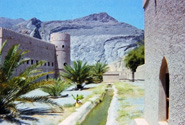Aflaj Irrigation Systems of Oman
Dakhiliya, Sharqiya and Batinah Regions

The property includes five aflaj irrigation systems and represents some 3,000 such systems still in use in Oman. The origins of this system of irrigation may date back to 500 A.D., but archaeological evidence suggests that irrigation systems existed in this extremely arid area as early as 2,500 B.C. Aflaj, is the plural of falaj which, in classical Arabic means to divide into shares and equitable sharing of a scarce resource to ensure sustainability remains the hallmark of this irrigation system. Using gravity, water is channelled from underground sources or springs to support agriculture and domestic use, often over many kilometres. The fair and effective management and sharing of water in villages and towns is still underpinned by mutual dependence and communal values and guided by astronomical observations. Numerous watchtowers built to defend the water systems form part of the listed property reflecting the historic dependence of communities on the aflaj system. Other buildings listed in association with the aflaj are mosques, houses, sundials, and water auction buildings. Threatened by the lowering level of the underground water table, the aflaj represent an exceptionally well-preserved form of land use.
Land of Frankincense
Dhofar Province
The frankincense trees of Wadi Dawkah and the remains of the caravan oasis of Shisr/Wubar and the affiliated ports of Khor Rori and Al-Balid vividly illustrate the trade in frankincense that flourished in this region for many centuries, as one of the most important trading activities of the ancient and medieval world.